So, let’s start with infrastructure. Peirce & Leslie is fabulous–exceedingly professional, attentive to every detail and willing, amiably, to turn on a dime to accomplish whatever we want to do. Like all good infrastructure, it’s virtually invisible, but makes an enormous difference in the travel experience. You may (or may not) pay a bit more, but, if you do, it’s worth every rupee.
We were blessed with excellent guides throughout. As any traveler knows, the quality of a guide has a dramatic impact on your experience. We were particularly fortunate to have Jay with us for ten days.
Spending most of the trip with Steve and Karen was a treat. They are easy, curious, smart and fun. Traveling with others is tricky, at best. Great friends do not necessarily make great travel companions. We count Steve and Karen in both categories, and only hope that they count us that way, as well.
The trip itself was terrific. Carol and I play a game at the end of each trip, separately listing our favorite moments of the trip. As usual, there was a strong correlation between our choices. With slight differences in order between us, the top ten were virtually identical. Carol did rank her blessing from a temple elephant putting his trunk on her head highly, and I certainly can’t disagree with that assessment. I only wish I’d been so blessed.
Mine were the caves (especially Ajanta), the Dabbawallas ( lunch deliverers in Mumbai), lunch with Sabita and family in Chennai, the dance recital in Chennai, putting the god to sleep ceremony at Minakshi temple, visiting Deborah the ceramicist in Pondicherry, dinner with Anil and his wife and friends in Mumbai, elephant bathing and procession in Cochin, the Dhobi Ghat (open air laundry) in Mumbai and the houseboat ride with Ashok in the backwaters of Kerala. The list was made en route to Mumbai, or I probably would have included the visit to the slums on that list. Other things that both Carol and I loved were the ox cart ride in Chettinad, the terra cotta horses, the movie and the wedding we crashed.
Striking, but not surprising about the list is that, with the exception of the caves, none of the top items is a temple, palace, fort or museum (to be fair, Carol ranked the bronze dancing Shivas we saw in a museum highly). Not that those all weren’t interesting and worthwhile, but it’s the personal and real life experiences that make a trip. I should add to the last sentence “for us.”
One of my favorite moments in the trip was when our guide, Jay, talked about taking Indian tourists to Europe and how what mattered most for them was singing and watching movies on a bus that was traveling on a highway at high speed, bringing home small souvenir/gifts to subtly show their status as travelers and, incidentally, seeing a place or two. He described this without being judgmental. What interested these people was having an experience different from their everyday lives and, in that sense, they were attracted by the same thing we are. I can also readily imagine sophisticated American travelers who are blown away by the architecture, history and museums. But not us. (Though I have to admit that we were blown away by the architecture, history and museums in Egypt. On that trip, though, we lacked the kind of personal connections and touches that we had on this trip.)
I’m always struck on a trip like this by what a privileged life we live. And, also, by what a sheltered and provincial one. Ours is a young and isolated country. What do we know of rulers from a thousand or fifteen hundred years ago? And how can we understand what it means to be invaded and ruled by different empires over the centuries? Are the countries we’ve invaded (or, excuse me, liberated or supported) in the last fifty years feeling what prior generations in India felt during the periods we heard about on this trip? Wouldn’t it be nice to have some of that kind of history, at least if you didn’t have to live through it? Or, have we achieved some of the “benefits” of invasion and colonization (how’s that for a concept?) through immigration and, if so, what do our current immigration policies portend for the future?
At times, I’ve poked a bit of fun at the religious stories or names we heard about. That’s just my approach to life; I don’t mean to belittle the beliefs of others. Religions and their appeal have real interest for me. To be honest, I love the Hindu stories and gods, and their many characteristics, incarnations and consorts, though I confuse them constantly. What right-thinking, sane person would not love to worship an elephant god who brings good luck? And how can one not respect a religion whose adherents not only wash themselves before entering the temple to worship their gods, but also scrub down the elephants who carry those gods?
Finally, I have to mention the world’s greatest travel companion, my wife. Sharing these trips with her increases the joy of traveling exponentially.
And, speaking of companions, thanks for following, and for your many encouraging comments. It’s been fun to have you along. I hope that you’ve enjoyed the trip, perhaps even learned something along the way, and that you’ll decide to join us again, when we go to Ghana in September. For you, no visa or inoculations required.
We’d booked dinner at the seafood restaurant at the hotel last night. Lovely rooftop setting overlooking the water, but when we determined that there were only full, 3-course dinners, we elected to move into History, where we’d eaten the night before. Rejected our first table in favor of one away from the live music, which was more pleasant/less dissonant than last night’s offering. Excellent, spicy duck dish.
Room service decided that we should have eggs Benedict for breakfast, rather than what we’d ordered the night before. After checking out, we are driven the hour and a quarter to the Cochin airport, escorted by a Peirce & Leslie agent, then handed off to another P&L agent at the airport who escorts us in, checks our bags, gets our boarding passes and points us in the direction of the security checkpoint. This is the type of personal service we have gotten throughout and, while one could most-likely make do with less, it’s undeniably nice, and greatly reduces the anxiety associated with air travel.
On the other end, we’re met by our P&L representative, Suresh, and the driver we’d had earlier in Mumbai, Mohammed (who, embarrassingly, we do not recognize). The message that we wanted a tour of the slums had not made its way to Suresh (who, we later found out, had been up all night working last night). He made a call and said, no problem, we will visit the slums, but we should not get out of the car, because it was Mohammed’s birthday (not our driver) and there were big crowds and celebrations. The celebrations would start late in the day, but we encountered some early parades, flags and loud music. Mohammed-the-driver will celebrate, too, and though he gets a call from his 8-year old son, who wants to know when he’ll be home to take him to the festivities, we never have a sense that Mohammed is rushing or anxious to drop us off.
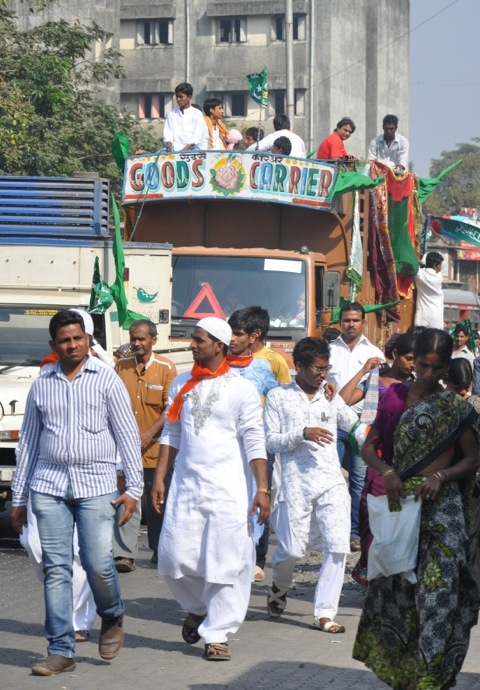
Instead of going to the slums near the airport, Suresh said he’d take us to the larger slum, where Slumdog Millionaire was filmed. En route, Suresh explained that 40% of the people in Mumbai (or 8 million people) lived in slums. People came from villages to the city, expecting to realize their dreams, but soon discovered the reality. Some 60-65% of those living in slums were Muslims, but the percentage was about 75% in the slum we were going to.
When we got to the slums, we did get out of the car and walked around for almost an hour, getting a surprising education along the way. There is industry in the slums, people making pottery, leather goods, candies. These are sold in shops just outside the slums for a fraction of the price they bring in other stores. People in the slums were very friendly, many wanting their pictures taken or to say hello and shake hands. In general, people looked clean and healthy, and happy. (I admit that I have no basis for saying the latter, but it was definitely my impression from looking at people and from the brief interactions that we had.) For people living there, Suresh says, the area is quite safe. So, while I’m not ready to move in quite yet, I emerged with quite a different impression than the one I had going in. We owe our good friend. Leslie Paul, a debt of gratitude for the education we got, because it was her persistence that convinced us that we needed to make the visit.
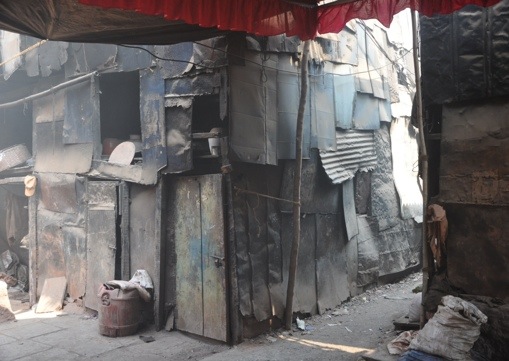
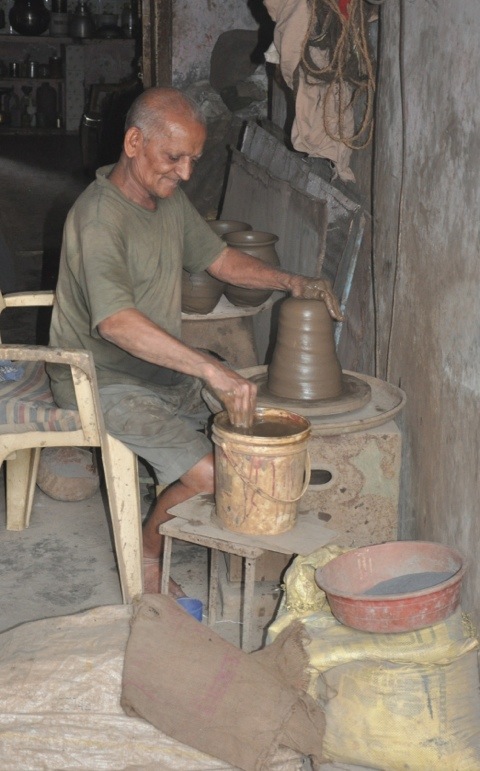
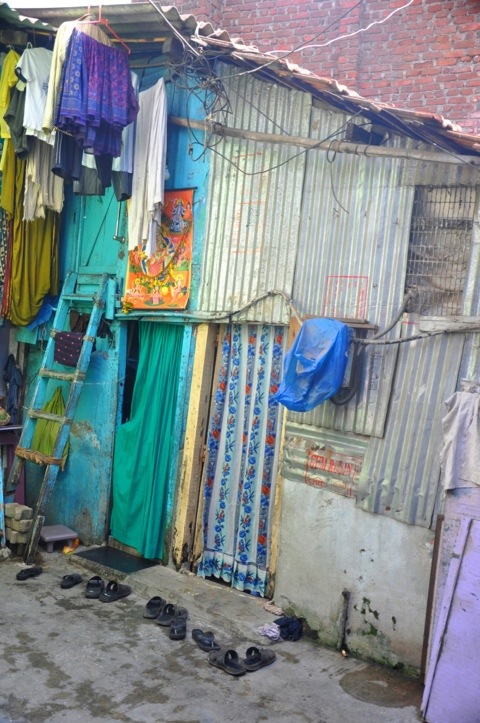
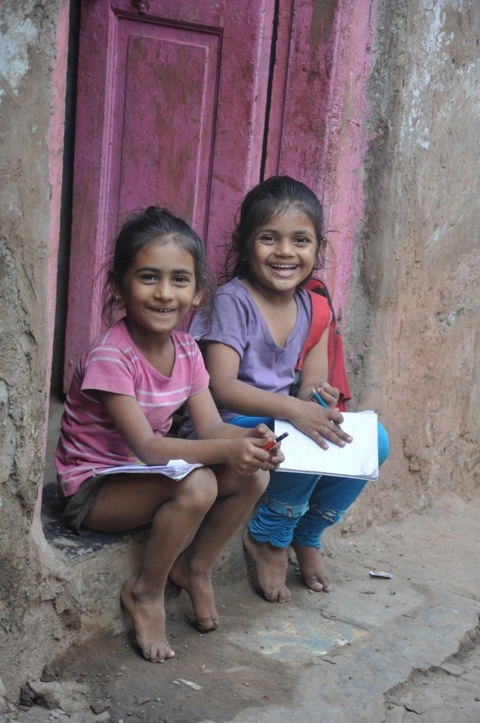
Across the street is an open lot, where boys are playing cricket. Looming over the lot is a large apartment block built by the government.
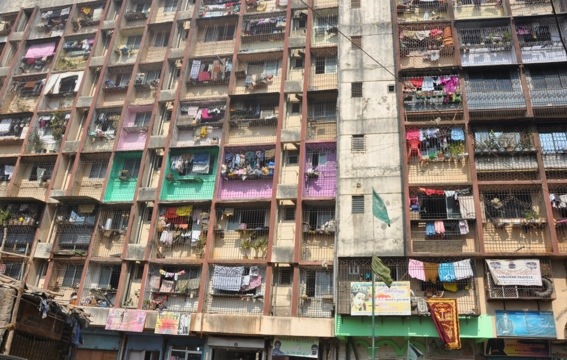
Suresh says that people will live there a short time, sell them at a profit and move back to the slums; not what the government had in mind. We walk past leather shops. Carol looks at belts, but does not buy. I go into the next store and wind up buying a pair of leather shoes, for $30. Suresh is a little delayed getting back to the bus because he, too, has bought a pair. When Carol and I admire them, he says I can get a pair like it, and walks me back to the store. Unfortunately, though, they had only one in that size, which he had bought. Despite my protestations, he insists that I take the pair he’s bought, since he can easily go back any time. So, I wind up with two pairs of leather shoes for sixty bucks. Such a deal.
We go from the slums to our decidedly upscale hotel, the Leela Kempinski, very near the international terminal of the airport that we need to get to at three in the morning. At the hotel, I manage to get my iPad, which just stopped working at the Cochin airport, to start again, with the help of the hotel IT guy. Carol and I go down for a good dinner at the hotel, and plan to retire very early in order to get up for the 2:15 AM room service breakfast that we just ordered.
I’ll try to wind up this blog with some reflections From the plane tomorrow.
We were told that we could not visit the Jewish Synagogue today, because it was Shabbat. On further inquiry yesterday, though, Jay found that there was a service that we could attend. After breakfast we drove, then walked, to the synagogue, where we were told services would start at 8:45. We walked past many interesting shops, some of which were been swept out and prepared for opening. We waited outside the synagogue, while the guard opened the door, but made it clear that we were not welcome to enter until a congregant arrived. The once-thriving Jewish community that numbered over 100,000 has dwindled to less than a minyan, almost all of them elderly.
More than an hour late, we were surprised to see a tall, thin man, dressed in black, with a hat and a long beard stride down the street, with a few others. Turns out that he is a member of Chabad from Israel who, with his wife, have lived in Cochin for more than two years, seeking to keep the Jewish community alive. We walked into the synagogue, the women sitting in an area in back, separate from the main synagogue. Eleven hundred handmade tiles decorate the floor, lamps and chandeliers from Europe hang from the ceiling, and wooden benches line the sides of the room. A wooden and brass circular structure is in the center and serves as the bimah.
We chat briefly with the rabbi, who asks our Hebrew names, which I know, but Steve does not. He asks how long we can stay and seems disappointed, but not surprised or dismissive, when we tell him only a short time. There are eleven men in the service, which I think is an unusual crowd for the synagogue. Several are young Israelis and one an older gentlemen, born in Rumania, but now living in Baltimore, who travels the world in his spice trade business. Certainly there could be no more appropriate place to pray than Cochin for one in that trade. He is friendly and chatty. He and his wife moved last night to a small hotel near the synagogue so that he could walk to services this morning.
The services are “led” first by one young man and then by the rabbi. “Led” consists of davening, sometimes inaudibly and sometimes chanting in the structure in the center. I can pick up and join in on only a few prayers. There is something sad and lovely about praying in this more than four century-old synagogue, knowing that Jews around the world are all participating in the same type of worship.
Of course, Jews were not the only foreigners to influence this area. Kerala, and especially Cochin, was one of the main ports on the spice route. The history of Kerala reflects the significant influences these spice traders left behind. Christianity first came to India through Kerala, and the Islamic influence in the state can be seen when traveling north. Even after they left, the cultural influence is still seen in the architecture of Cochin.
We stay at the synagogue for less than an hour, make a contribution on the way out and then wander back to our bus past interesting stores that we do not have any real time to explore.
We walk with Jay and the Sugarmans along the area that Carol and I walked yesterday morning, and Jay explains what is going on. We stop to watch some very quick auctions of freshly caught fish that will be taken to hotels and shops, and sold today.
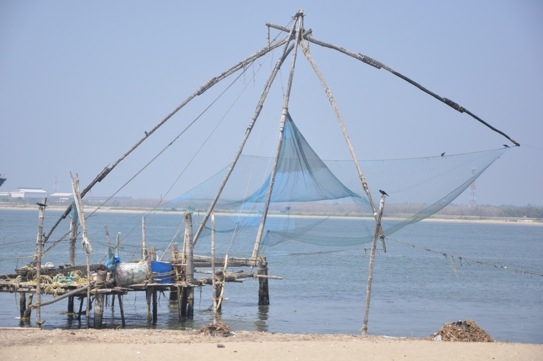
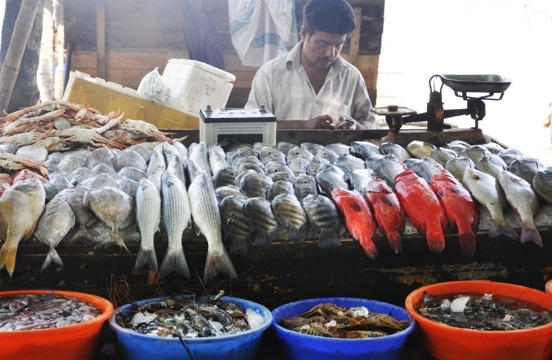
We continue walking through the narrow roads of the area that is today referred to as the Heritage Zone, seeing various architectural styles reflecting the many cultures that lived here. Dutch houses stand next to spacious porticoed British plantation style homes. Further down, we go through the Church of St Francis, built by the Portuguese.
We return to the hotel and have lunch with the Sugarmans, who are about to check out of the hotel, as they are moving to a new city in Kerala tonight.
We take the bus to the Mattancherri Palace, which was commissioned by the Portuguese for the Raja of Kochi in exchange for trading rights, and remodeled extensively by the Dutch. The palace is two stories high and is built in the traditional Kerala style known as “nalukattu” (four buildings around a central courtyard). Made of wood and richly carved, the palace exhibits memorabilia from the Raja of Kochi’s collection, but it is best known for its outstanding murals painted on the walls. Fast fading, you can still see some of these excellent 16th century paintings illustrating episodes from the great Indian epic – The Ramayana. This is an interesting place, but we don’t really have enough time to digest it.
Kochi’s ancient Shiva Temple is popularly known as Ernakulathappan (catchy, huh?). The annual festival in the deity’s honor, Ernakulathappan Uthsavom, is today and includes a procession with caparisoned elephants, special pujas, classical dances, concerts and firework displays. Because of our timing, we are able only to catch the bathing and decorating of the elephants, but that is quite fun to see, and, at least we had a taste of the festival (albeit a small taste) last night. Too bad that we can’t see the full-blown festival, but you can’t catch everything.
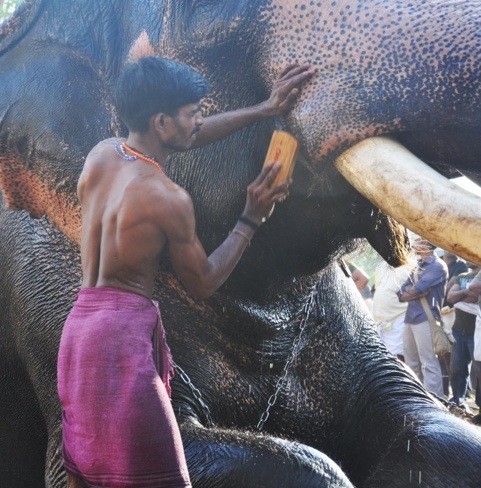
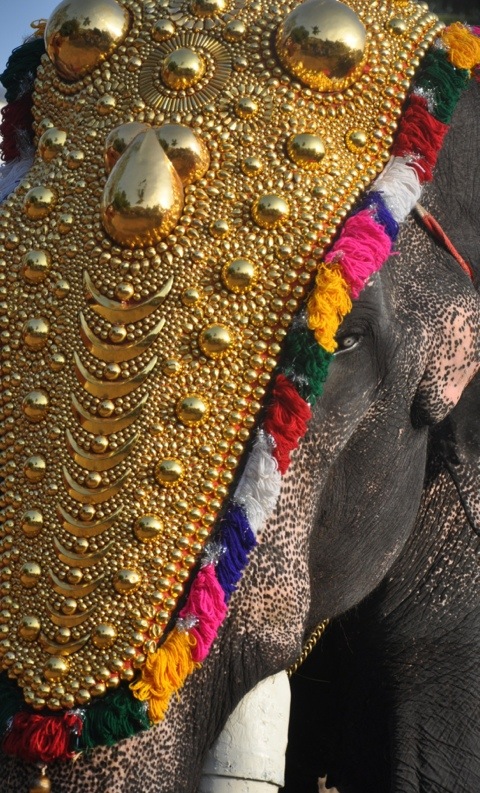
We say goodbye to Karen and Steven. In a touching show I’d affection, Karen gives Carol and me six Sodukos (or however you spell the damn things) to frustrate us on our trip home. It’s been as marvelous to be with the Sugarmans as we’d anticipated, and we had very high expectations.
We ride back to the hotel and say goodbye to Jay, who has been a wonderful guide. He is knowledgable on an incredible range of topics, and could not have been more flexible in accommodating all of our whims and changes of plans. Most recently, he facilitated, with Shonali and her amazing group at Peirce & Leslie, getting an earlier flight to Mumbai tomorrow, arranging for us to see some of the slums there and changing the arrival time for us at the hotel in Mumbai.
Carol is at an hour-long cooking class that she had signed up for yesterday, but missed because of our late return to the hotel. We missed an hour-long cruise we’d booked at the hotel for 5:30, but we knew that was extremely iffy.
Breakfast outside on the water is very pleasant (and slow). Carol and I walk into town by the sea to watch fisherman raise and lower the large, counter-weighted Chinese fishing nets, hung on spider-like wooden arms, to pull in the the fish and sell them in stalls. A sign on a restaurant says, “You buy it, we cook it.”
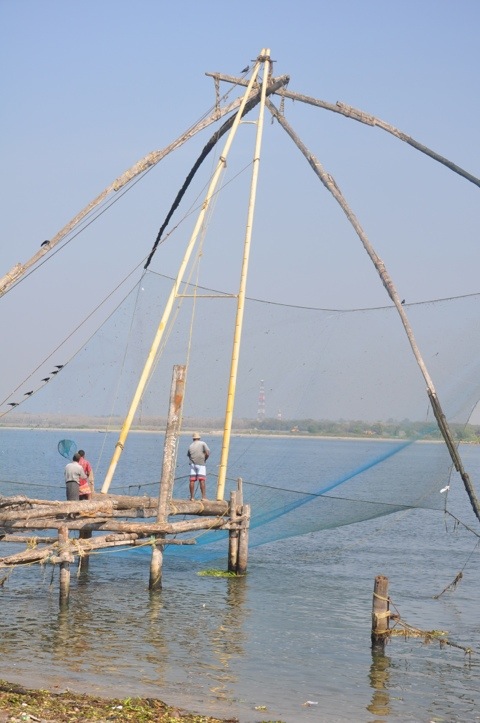
Driving to Alleppy, we pass some elephants, decorated for participation in one of the temple festivals going on. We are to visit one of the festivals tomorrow.
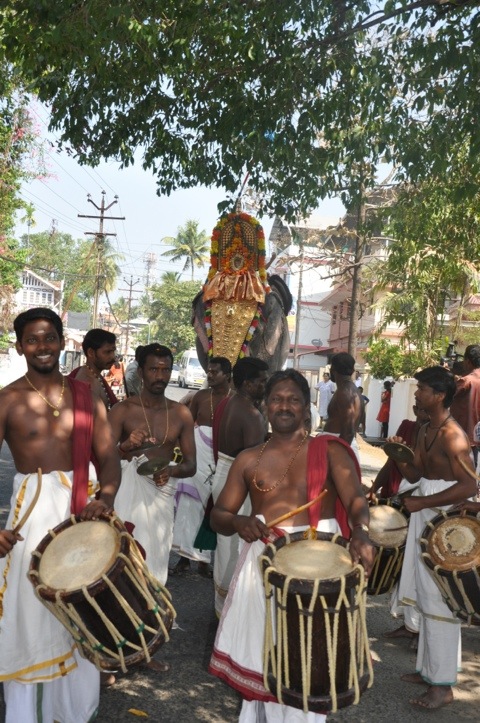
After more than an hour, we arrive at Alleppy, where we board our houseboat to begin our tour of the famous Kerala backwaters, a leisurely journey through the Kuttanadu area of the backwaters. This is one of the few areas where farming is done below sea level, fields having been reclaimed from what once was a lake. We travel through the labyrinthine maze of canals and waters ways passing rice paddy fields, banana and coconut plantations, small villages and boats commuting between villages and ferrying children to school and farmers to the markets. We see coracles, small, round, bamboo boats from which a small family fishes and later uses the boat as shelter to sleep on the shore.
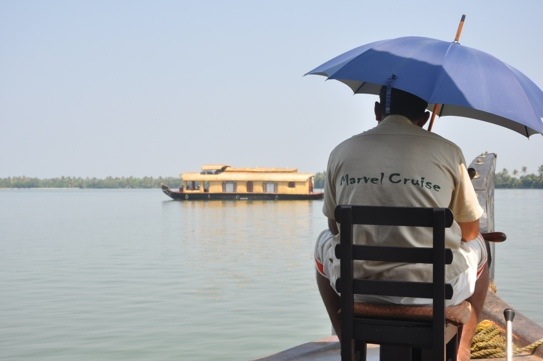

Our houseboat has two bedrooms and baths, a comfortable, shaded deck area and a kitchen from which an excellent lunch is prepared for us. We are joined by Ashok Koshy, a charming fellow who has lived in England, travelled in the US and has a home in the backwaters. Ashok is a professional photographer and an avid flutist. As he and a colleague have collaborated on a book of photos and poems, he, Carol and I have a lot in common to talk about. Our four and a half hours on the boat are delightful and a very relaxing change of pace.
In the bus, Jay regales us with very amusing stories about large groups of Indians who he takes to Europe, who want nothing more than to sing and watch movies as their tour bus travels at high speeds on uncrowded highways. Anything they may see outside is incidental to the trip, the main thrust of which takes place on the bus. They will travel only in a group and are uneasy about venturing anywhere without his say-so. This is an interesting and astounding difference from the travel we do.
While Jay extolls the virtues of Kerala, he is also frank to admit the problems. One of the primary issues is a high alcoholism rate, which creates many attendant problems, including some periodic mass family suicides to avoid the debt collectors they cannot pay. The government has now made all liquor sales come from government-owned stores, and we see lines of men outside these stores, waiting to buy liquor.
On our way back to the hotel, we pass a procession of musicians and three elephants making their way to a temple for a festival, guided by mahouts, the elephant trainers who live with them. The elephants stop at homes along the way for offerings to the god, and we are offered bananas by a smiling 10-year old girl at one of the houses.
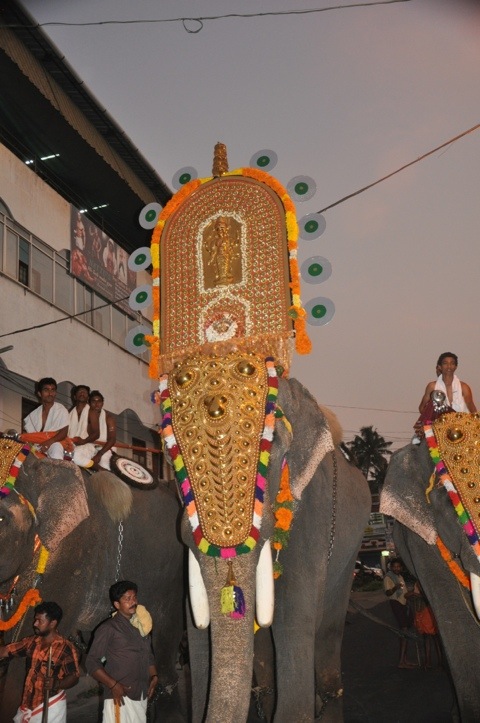
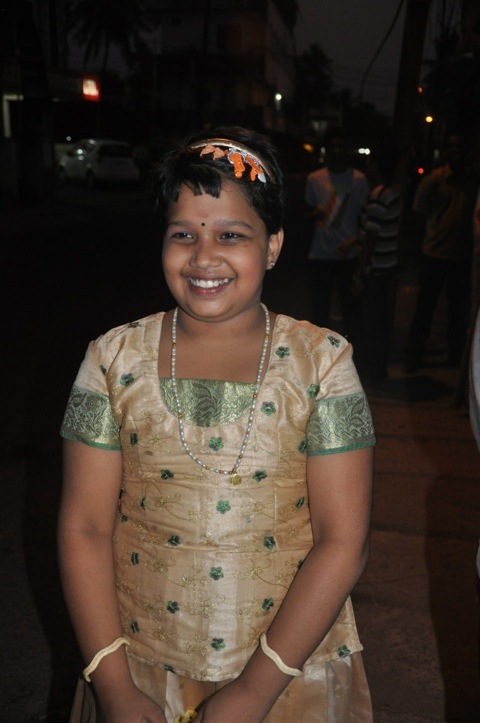
After returning to the hotel, we have an excellent dinner at History restaurant, on the second floor of Brunton Boatyard.
Today is a travel day. We spend the morning at the hotel, relaxing, as running back into town (half hour drive each way) to see more of the markets does not seem worth it. As there are no direct flights, to get to Cochin from Madurai, we need to fly first to Chennai, which is in the wrong direction. There we have over three hours in the airport, before connecting to Cochin. If we had another day or two, we would have driven the ten hours from Madurai to Cochin, crossing the mountains, seeing tea plantations and, perhaps, even stopping at a game preserve. That would have been nice.
I have not commented on the begging, which is a disturbing element of travel in India. It occurs primarily around temple areas in the South. As advised, we do not respond to beggars, but they are a reminder of the gaps between haves and have-nots, in India and around the world.
Though I’ve alluded to the traffic, I probably have not given an adequate sense of the chaos and harrowing nature of travel by road. There is a constant din of honking, so much so that I asked Jay whether it’s possible to buy a car that honks automatically every four seconds, to save the driver the effort. This honking affects one as a pedestrian, as well, causing you, at first, to jump each time you hear it, walking along the street, or crossing over. After a while, though, you become inured to and ignore it, and learn that the trick to crossing the street is to appear oblivious to the traffic bearing down on you.
Contrasting elements of every day life are the incredible color of Indian life and the garbage, strewn everywhere, and especially along the roads. The predominance of plastic refuse is a ready reminder of the vexatious nature of that substance. So far as one can tell, Indians are oblivious to the trash. Jay says it is a matter of education.
Read The Hindu newspaper at breakfast, which gives one a good sense of what’s going on. The virulent attacks by one political party against another demonstrates that we’re not alone in that regard, and a small article, buried in the middle of the paper, about Romnay’s decisive win over Gingrich in Florida is a reminder that the US is not the center of the universe to the rest of the world. An interesting side note is an article about the movie The Help, and a reflection on its implications for Indian domestic workers.
Spend part of our free time during travel discussing with Jay the myriad differences between North and South India. History: the North was invaded and controlled by Aryans. Language: North language is Hindi, having common ties to languages of Europe, while South is Dravidian. Food: a different, larger kind of rice in South, North has corn and wheat in meals. Infrastructure: much better in South. Education: better in South. Weather: South has weather that’s the sane, year-around, with either one or two predictable monsoon seasons; weather in North has extremes of heat and cold. Religion: South 85% Hindu, North more than 20% Muslim and was about 50% prior to partition and creation of Pakistan. Darker skinned people In South. South economically better off than North.
Travel is okay, but long, especially since I’m not feeling at the top of my game. Arriving in Kerala and driving an hour and a quarter to our hotel in Cochin, one notices immediate differences. Billboards are for much more upscale products and are virtually entirely in English. We pass huge Toyota and other car dealerships, and large shopping malls. Roads are much better with no traffic coming right at us and no honking. Of course, that’s not to say that we don’t pass three heavily-decorated elephants being used for a temple festival. Communist party flags line the road because of a big conference to be held in the area. Communists have been democratically elected from time to time.
We reach the Brunton Boatyard, a relatively new hotel (ten or so years), with a very gracious, old feel to it. We have large suites, looking out on the water; extremely comfortable. Service at the restaurant is slow, and, as I’m not feeling that great, I eat only about half of my roast beef (people in Kerala eat beef) sandwich, before going up to the room.
|
|
















